brake Lexus GX470 2007 Instrument cluster / LEXUS 2007 GX470 (OM60C64U) User Guide
[x] Cancel search | Manufacturer: LEXUS, Model Year: 2007, Model line: GX470, Model: Lexus GX470 2007Pages: 436, PDF Size: 11.52 MB
Page 115 of 436
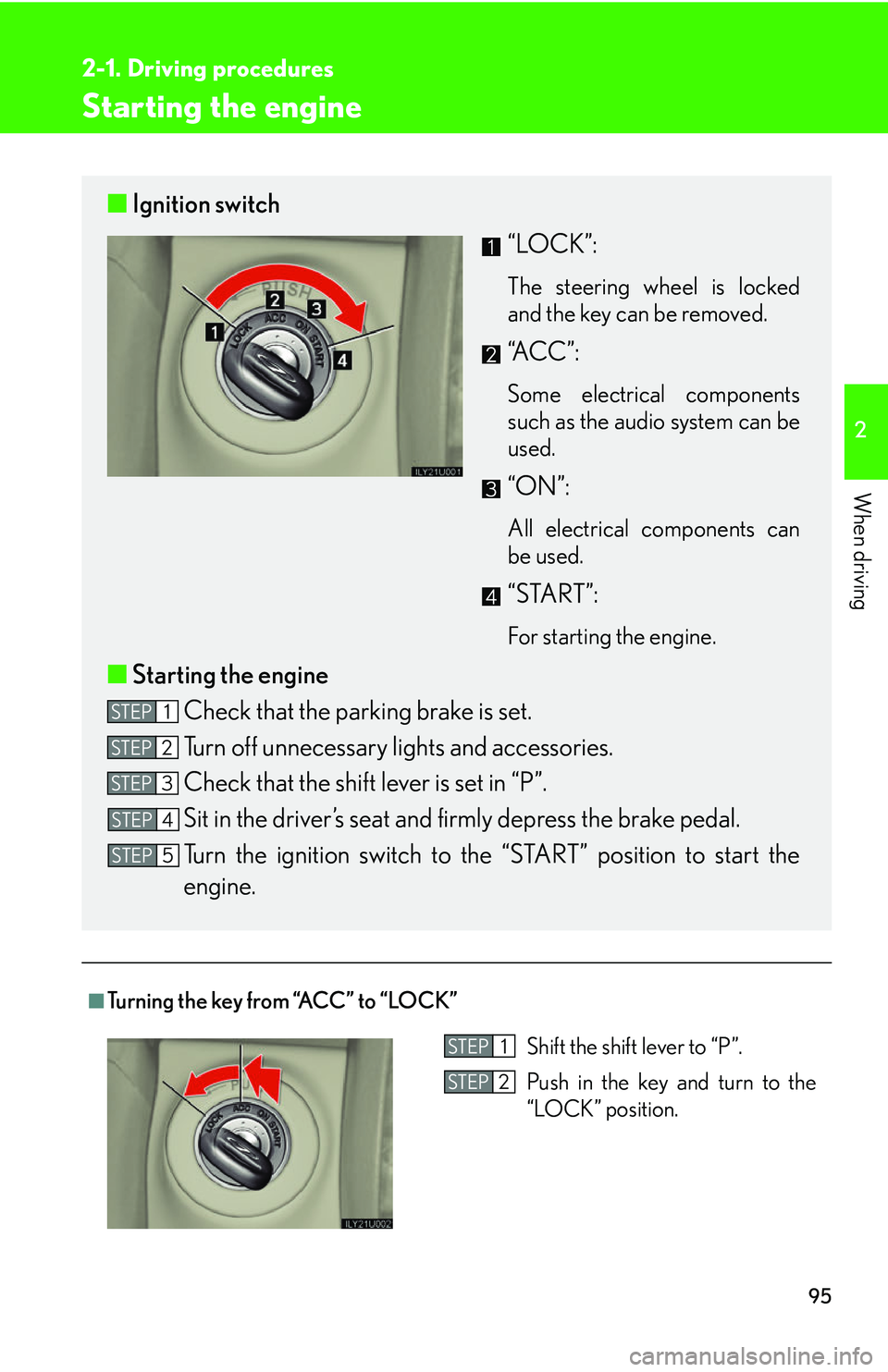
95
2-1. Driving procedures
2
When driving
Starting the engine
■Turning the key from “ACC” to “LOCK”
■Ignition switch
“LOCK”:
The steering wheel is locked
and the key can be removed.
“A C C ” :
Some electrical components
such as the audio system can be
used.
“ON”:
All electrical components can
be used.
“START”:
For starting the engine.
■Starting the engine
Check that the parking brake is set.
Turn off unnecessary lights and accessories.
Check that the shift lever is set in “P”.
Sit in the driver’s seat and firmly depress the brake pedal.
Turn the ignition switch to the “START” position to start the
engine.
STEP1
STEP2
STEP3
STEP4
STEP5
Shift the shift lever to “P”.
Push in the key and turn to the
“LOCK” position.STEP1
STEP2
Page 118 of 436
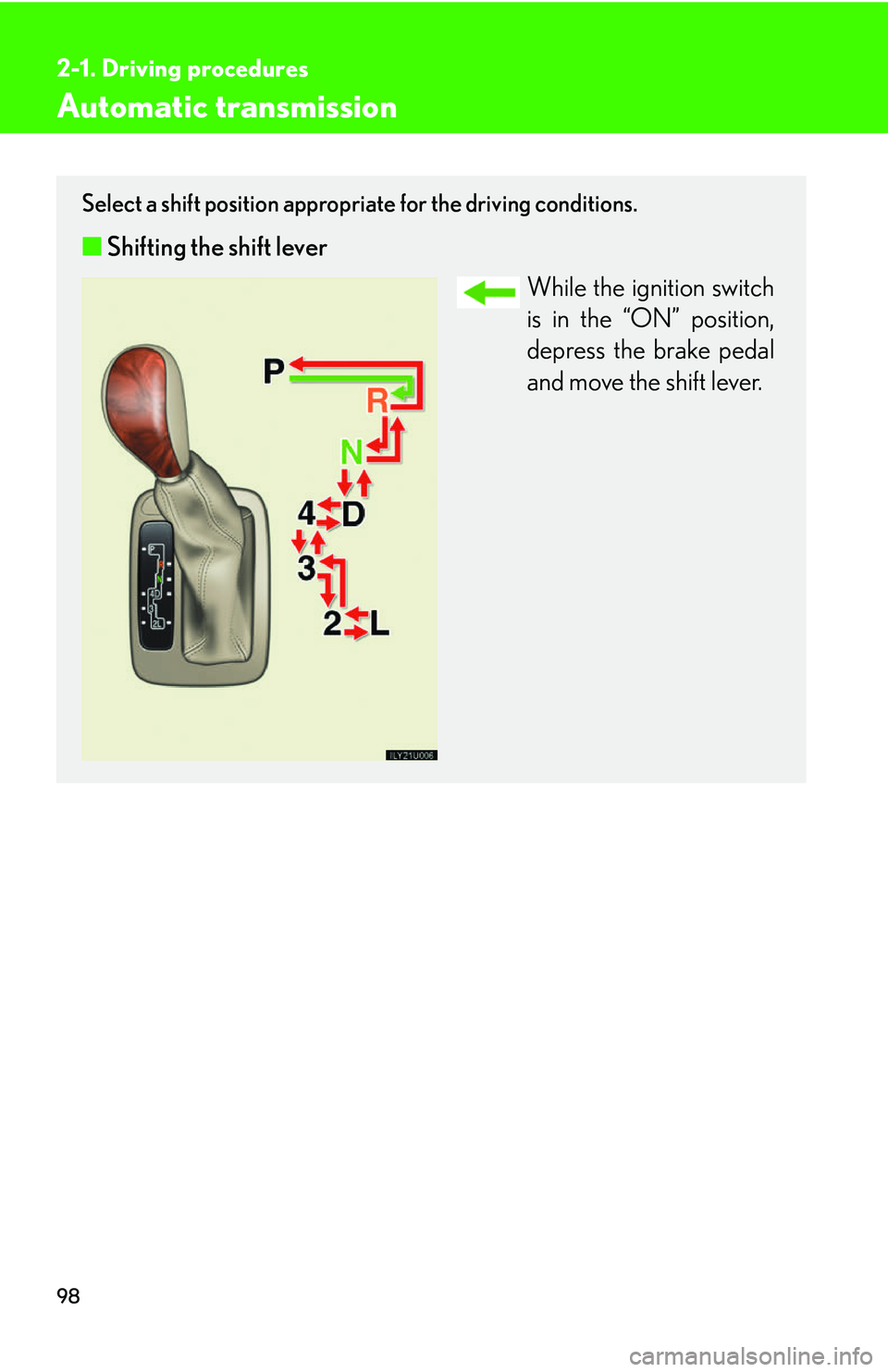
98
2-1. Driving procedures
Automatic transmission
Select a shift position appropriate for the driving conditions.
■Shifting the shift lever
While the ignition switch
is in the “ON” position,
depress the brake pedal
and move the shift lever.
Page 120 of 436
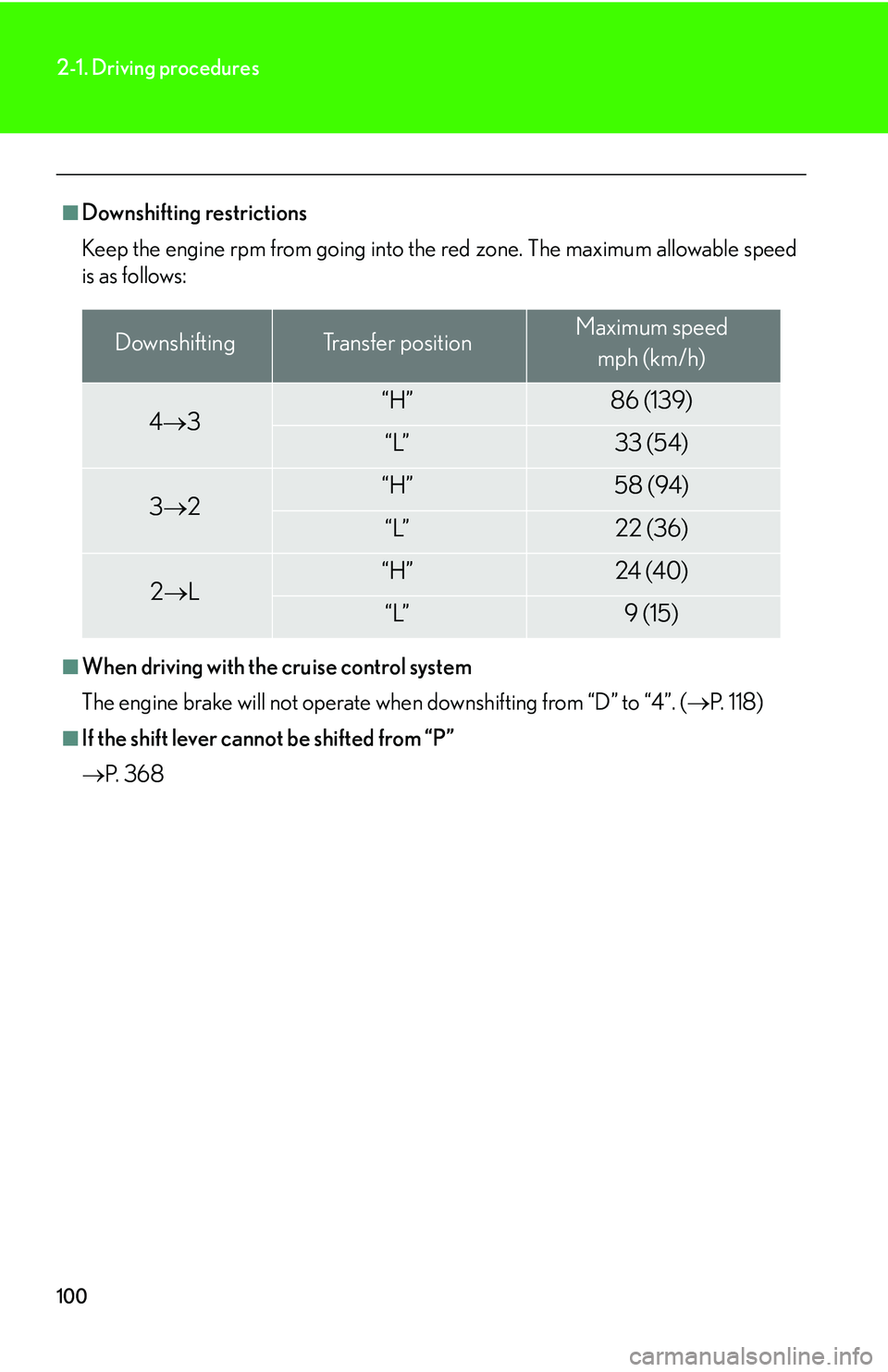
100
2-1. Driving procedures
■Downshifting restrictions
Keep the engine rpm from going into the red zone. The maximum allowable speed
is as follows:
■When driving with the cruise control system
The engine brake will not operate when downshifting from “D” to “4”. (P. 1 1 8 )
■If the shift lever cannot be shifted from “P”
P. 3 6 8
DownshiftingTr a n s f e r p o s i t i o nMaximum speed
mph (km/h)
4 3“H”86 (139)
“L”33 (54)
3 2“H”58 (94)
“L”22 (36)
2 L“H”24 (40)
“L”9 (15)
Page 122 of 436
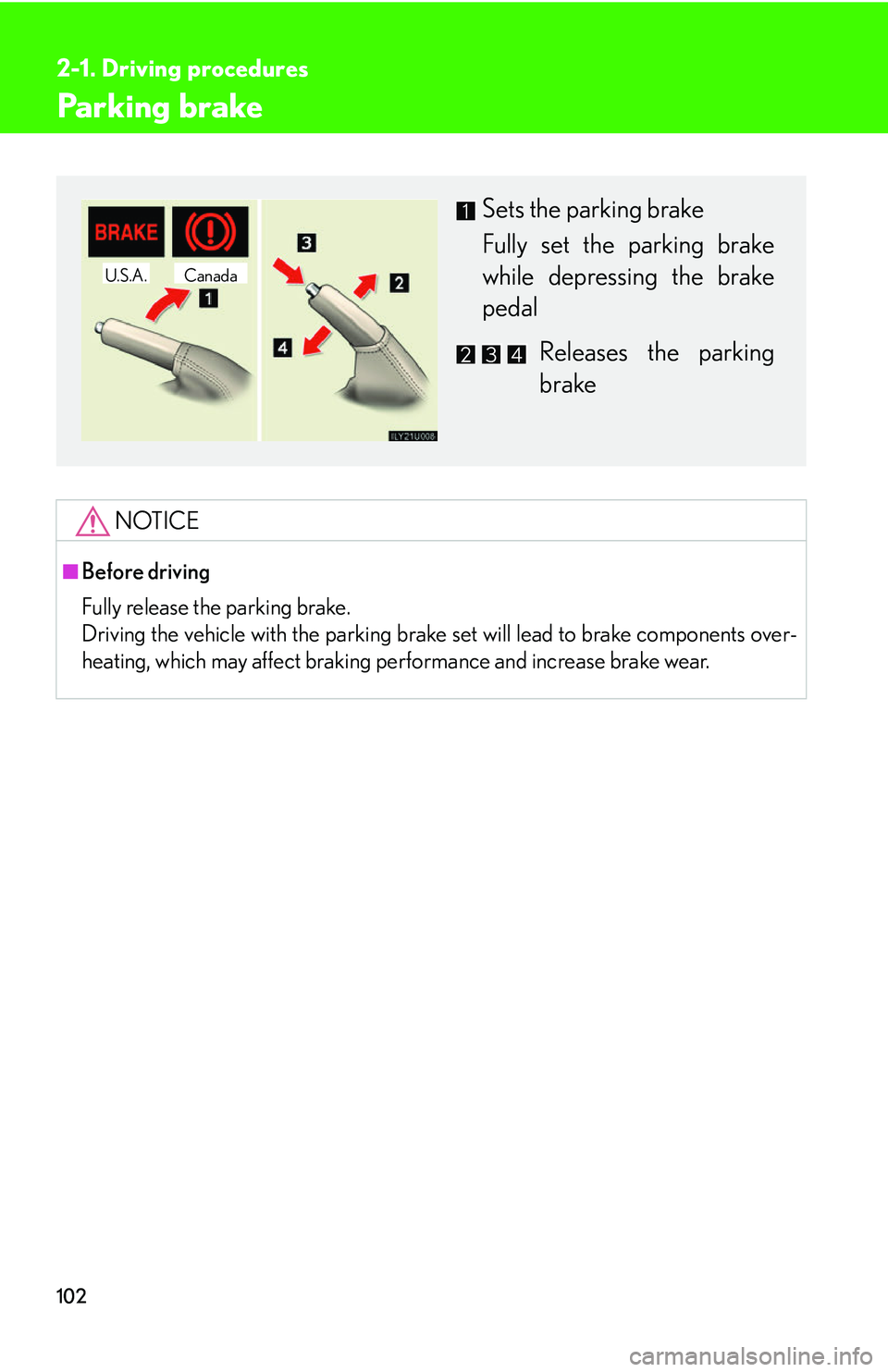
102
2-1. Driving procedures
Parking brake
NOTICE
■Before driving
Fully release the parking brake.
Driving the vehicle with the parking brake set will lead to brake components over-
heating, which may affect braking performance and increase brake wear.
Sets the parking brake
Fully set the parking brake
while depressing the brake
pedal
Releases the parking
brake
CanadaU.S.A.
Page 132 of 436
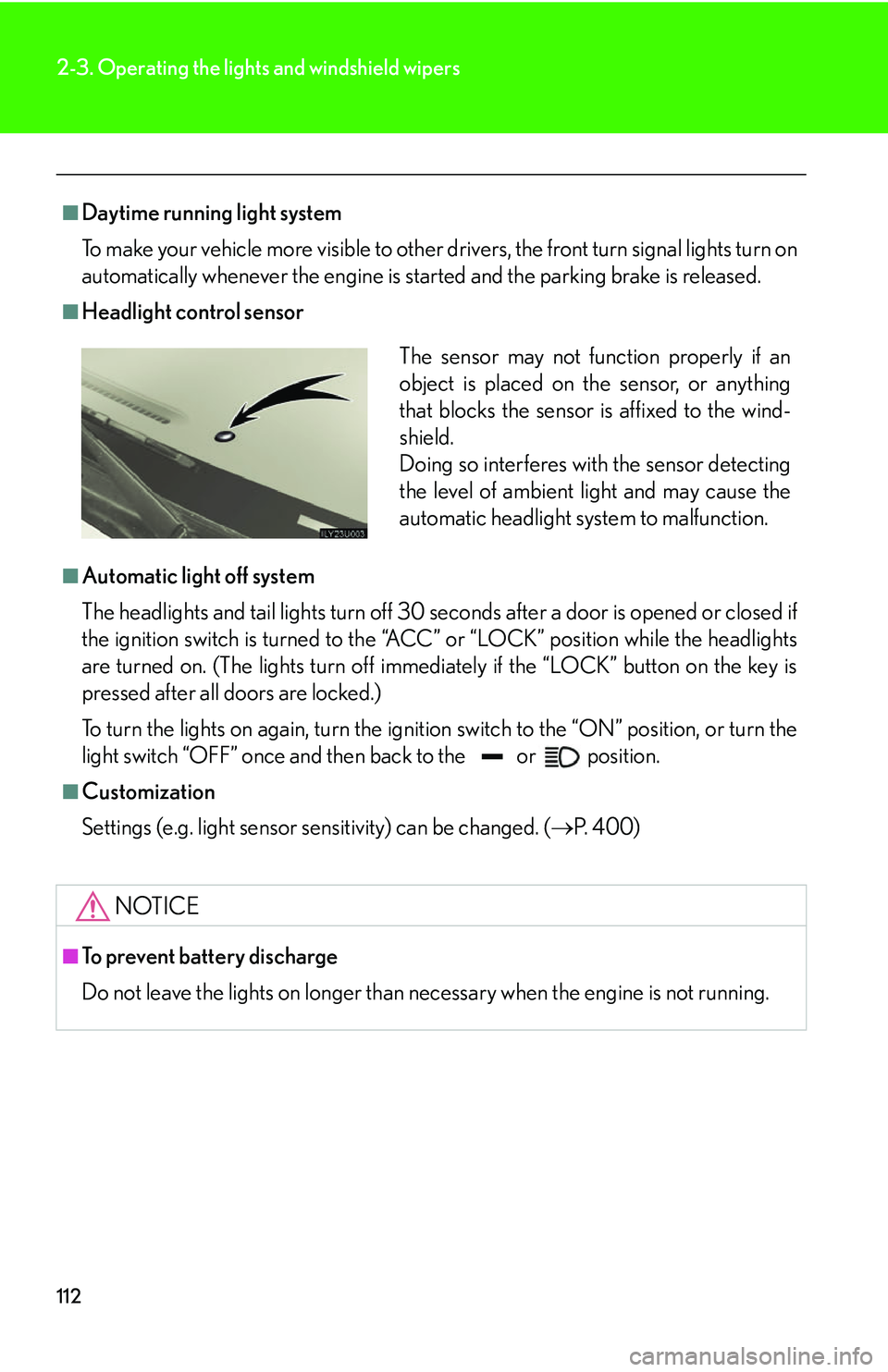
112
2-3. Operating the lights and windshield wipers
■Daytime running light system
To make your vehicle more visible to other drivers, the front turn signal lights turn on
automatically whenever the engine is started and the parking brake is released.
■Headlight control sensor
■Automatic light off system
The headlights and tail lights turn off 30 seconds after a door is opened or closed if
the ignition switch is turned to the “ACC ” or “LOCK” position while the headlights
are turned on. (The lights turn off immedi ately if the “LOCK” button on the key is
pressed after all doors are locked.)
To turn the lights on again, turn the igniti on switch to the “ON” position, or turn the
light switch “OFF” once and th en back to the or position.
■Customization
Settings (e.g. light sensor sensitivity) can be changed. ( P. 400)
NOTICE
■To prevent battery discharge
Do not leave the lights on longer than necessary when the engine is not running.
The sensor may not function properly if an
object is placed on the sensor, or anything
that blocks the sensor is affixed to the wind-
shield.
Doing so interferes with the sensor detecting
the level of ambient light and may cause the
automatic headlight system to malfunction.
Page 139 of 436
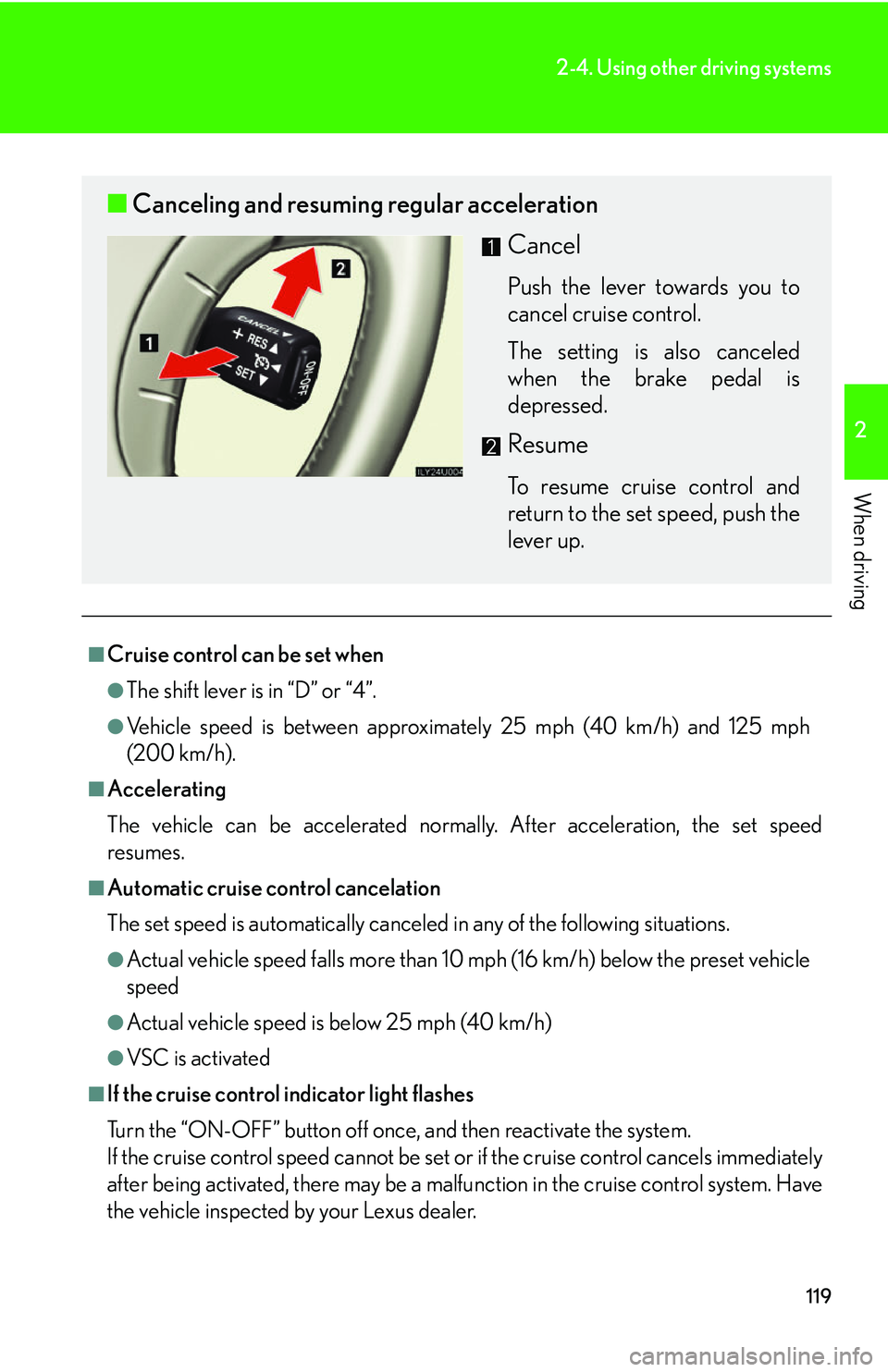
119
2-4. Using other driving systems
2
When driving
■Cruise control can be set when
●The shift lever is in “D” or “4”.
●Vehicle speed is between approximately 25 mph (40 km/h) and 125 mph
(200 km/h).
■Accelerating
The vehicle can be accelerated normally. After acceleration, the set speed
resumes.
■Automatic cruise control cancelation
The set speed is automatically canceled in any of the following situations.
●Actual vehicle speed falls more than 10 mph (16 km/h) below the preset vehicle
speed
●Actual vehicle speed is below 25 mph (40 km/h)
●VSC is activated
■If the cruise control indicator light flashes
Turn the “ON-OFF” button off once, and then reactivate the system.
If the cruise control speed cannot be set or if the cruise control cancels immediately
after being activated, there may be a malfun ction in the cruise control system. Have
the vehicle inspected by your Lexus dealer.
■ Canceling and resuming regular acceleration
Cancel
Push the lever towards you to
cancel cruise control.
The setting is also canceled
when the brake pedal is
depressed.
Resume
To resume cruise control and
return to the set speed, push the
lever up.
Page 151 of 436

131
2-4. Using other driving systems
2
When driving
■Operating tips
The system will operate when the shift lever is in a position other than “P”, however
to make effective use of the system it is recommended that the shift lever be shifted
to “2” or “L”.
■If the four wheel drive control lever is in “H”
The system will not operate.
■If the brake system overheats
The system will cease operation and a bu zzer will sound to alert the driver.
Stop the vehicle in a safe place. (There is no problem with continuing normal driv-
ing.)
■System malfunction
●The “DAC” indicator does not come on when the ignition key is turned to the
“ON” position.
●The “DAC” indicator does not come on when the “DAC” switch is pressed.
In the above cases have your vehicle checked by your Lexus dealer.
CAUTION
■The system may not operate on the following surfaces, which may lead to an acci-
dent causing death or serious injury.
●Slippery surfaces such as wet or muddy roads
●Icy surfaces
●Unpaved roads
Page 152 of 436
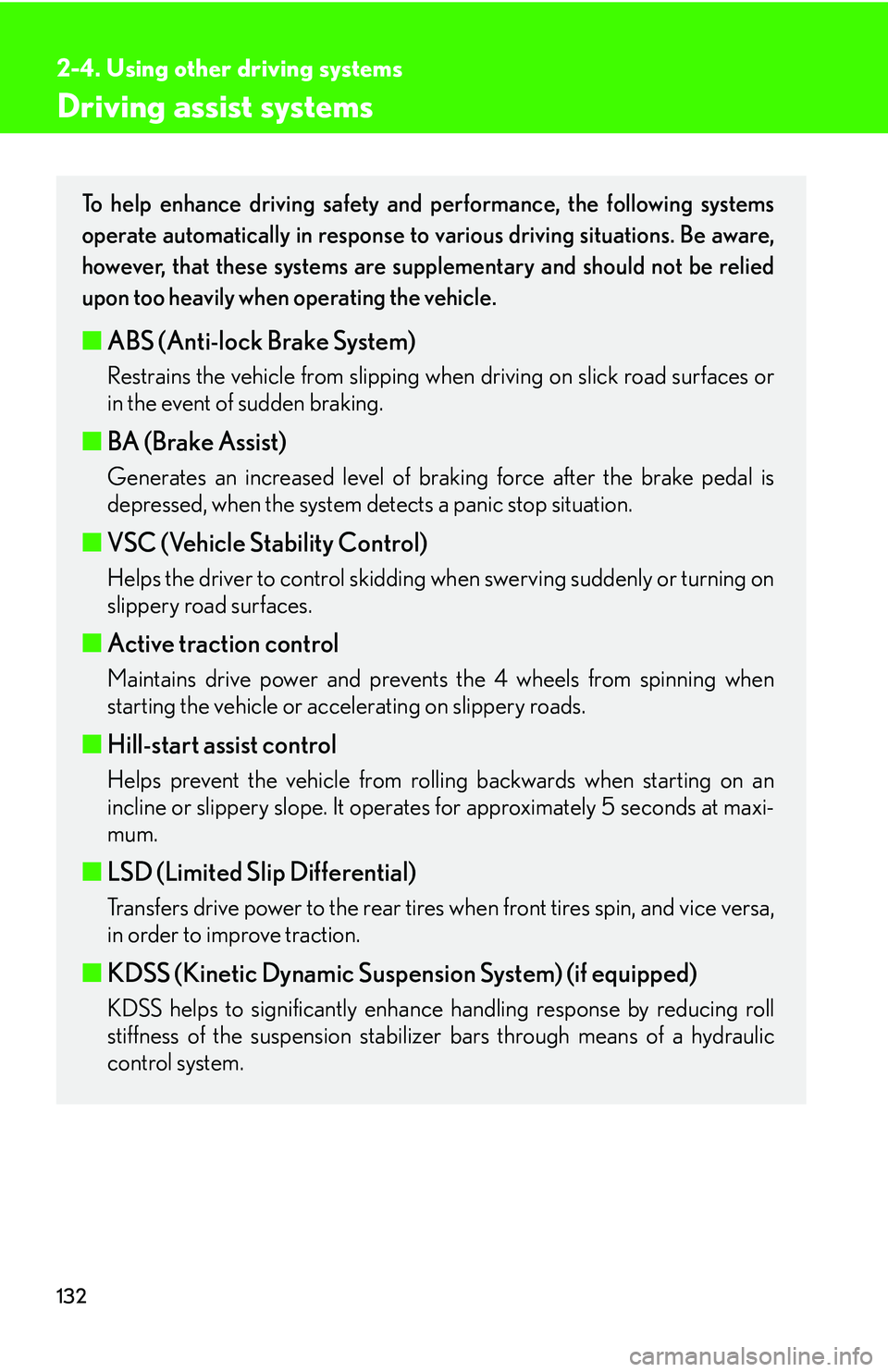
132
2-4. Using other driving systems
Driving assist systems
To help enhance driving safety and performance, the following systems
operate automatically in response to various driving situations. Be aware,
however, that these systems are supplementary and should not be relied
upon too heavily when operating the vehicle.
■ABS (Anti-lock Brake System)
Restrains the vehicle from slipping when driving on slick road surfaces or
in the event of sudden braking.
■BA (Brake Assist)
Generates an increased level of braking force after the brake pedal is
depressed, when the system detects a panic stop situation.
■VSC (Vehicle Stability Control)
Helps the driver to control skidding when swerving suddenly or turning on
slippery road surfaces.
■ Active traction control
Maintains drive power and prevents the 4 wheels from spinning when
starting the vehicle or accelerating on slippery roads.
■Hill-start assist control
Helps prevent the vehicle from rolling backwards when starting on an
incline or slippery slope. It operates for approximately 5 seconds at maxi-
mum.
■ LSD (Limited Slip Differential)
Transfers drive power to the rear tires when front tires spin, and vice versa,
in order to improve traction.
■KDSS (Kinetic Dynamic Suspension System) (if equipped)
KDSS helps to significantly enhance handling response by reducing roll
stiffness of the suspension stabilizer bars through means of a hydraulic
control system.
Page 153 of 436
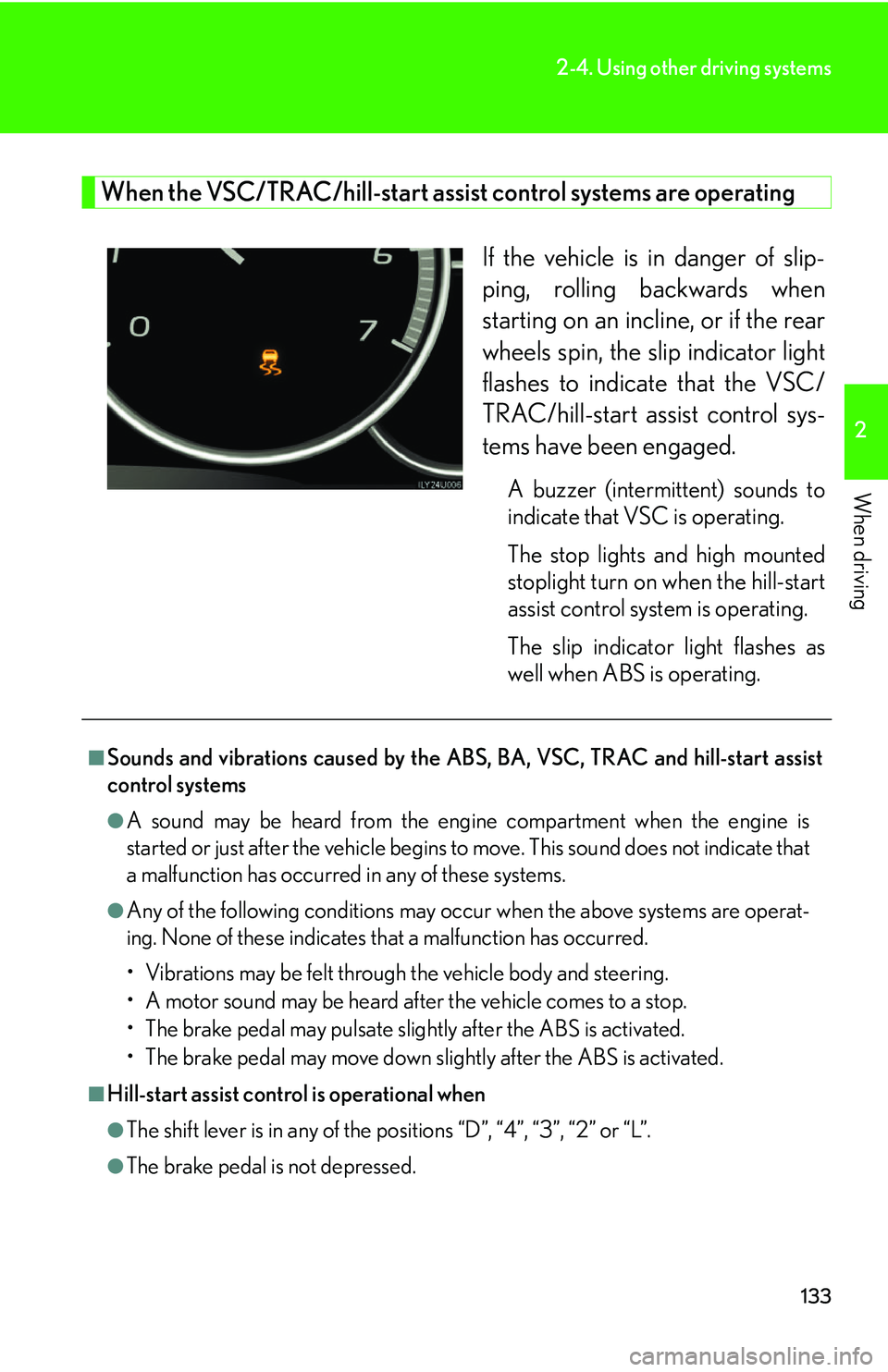
133
2-4. Using other driving systems
2
When driving
When the VSC/TRAC/hill-start assist control systems are operating
If the vehicle is in danger of slip-
ping, rolling backwards when
starting on an incline, or if the rear
wheels spin, the slip indicator light
flashes to indicate that the VSC/
TRAC/hill-start assist control sys-
tems have been engaged.
A buzzer (intermittent) sounds to
indicate that VSC is operating.
The stop lights and high mounted
stoplight turn on when the hill-start
assist control system is operating.
The slip indicator light flashes as
well when ABS is operating.
■Sounds and vibrations caused by the ABS, BA, VSC, TRAC and hill-start assist
control systems
●A sound may be heard from the engi ne compartment when the engine is
started or just after the vehicle begins to move. This sound does not indicate that
a malfunction has occurred in any of these systems.
●Any of the following conditions may occur when the above systems are operat-
ing. None of these indicates that a malfunction has occurred.
• Vibrations may be felt through the vehicle body and steering.
• A motor sound may be heard after the vehicle comes to a stop.
• The brake pedal may pulsate slightly after the ABS is activated.
• The brake pedal may move down s lightly after the ABS is activated.
■Hill-start assist control is operational when
●The shift lever is in any of the positions “D”, “4”, “3”, “2” or “L”.
●The brake pedal is not depressed.
Page 158 of 436
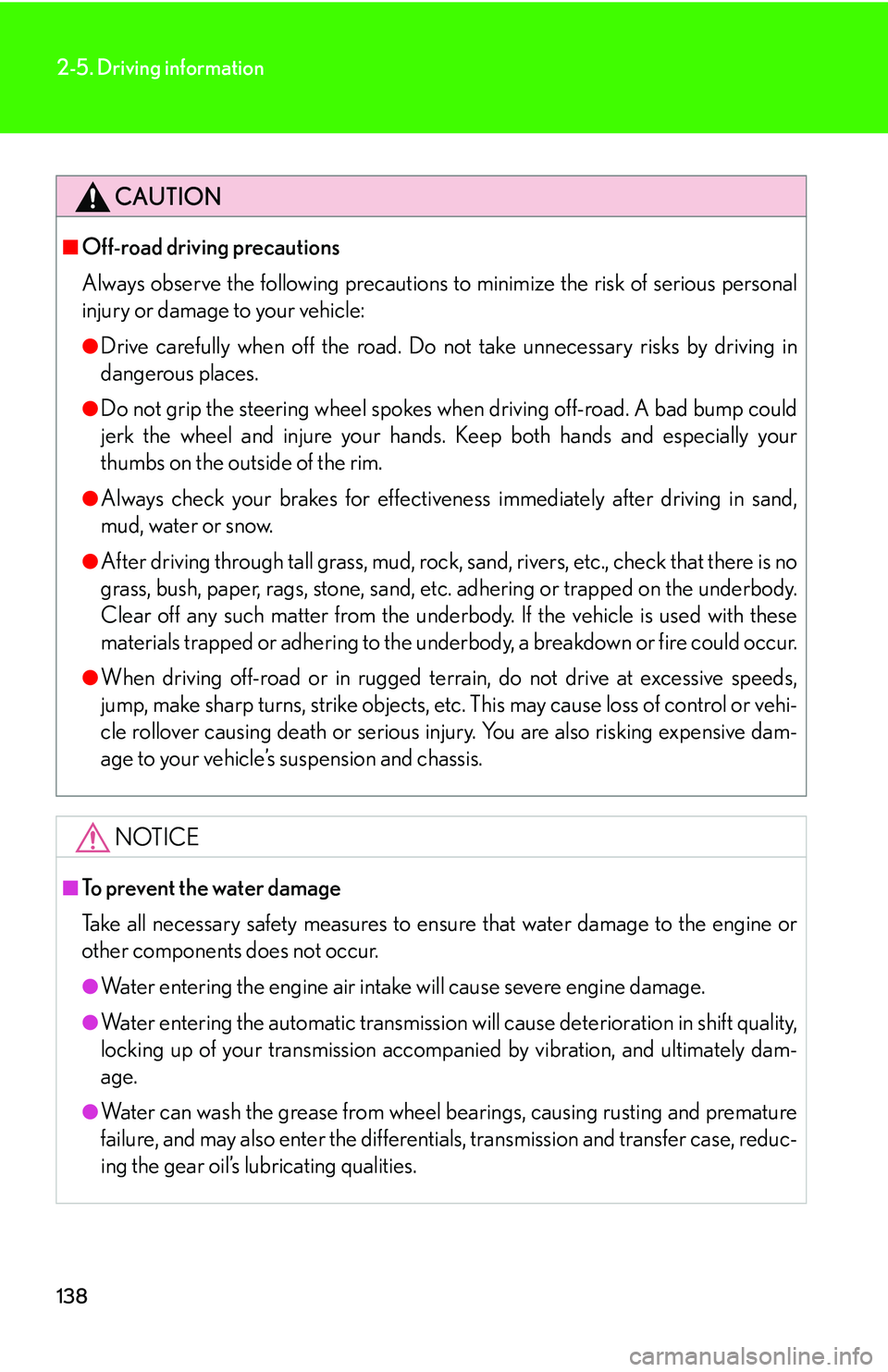
138
2-5. Driving information
CAUTION
■Off-road driving precautions
Always observe the following precautions to minimize the risk of serious personal
injury or damage to your vehicle:
●Drive carefully when off the road. Do not take unnecessary risks by driving in
dangerous places.
●Do not grip the steering wheel spokes wh en driving off-road. A bad bump could
jerk the wheel and injure your hands. Keep both hands and especially your
thumbs on the outside of the rim.
●Always check your brakes for effectiveness immediately after driving in sand,
mud, water or snow.
●After driving through tall grass, mud, rock, sand, rivers, etc., check that there is no
grass, bush, paper, rags, stone, sand, etc. adhering or trapped on the underbody.
Clear off any such matter from the underbody. If the vehicle is used with these
materials trapped or adhering to the underbody, a breakdown or fire could occur.
●When driving off-road or in rugged te rrain, do not drive at excessive speeds,
jump, make sharp turns, strike objects, etc. This may cause loss of control or vehi-
cle rollover causing death or serious injury. You are also risking expensive dam-
age to your vehicle’s suspension and chassis.
NOTICE
■To prevent the water damage
Take all necessary safety measures to ensure that water damage to the engine or
other components does not occur.
●Water entering the engine air intake will cause severe engine damage.
●Water entering the automatic transmission will cause deterioration in shift quality,
locking up of your transmission accompanied by vibration, and ultimately dam-
age.
●Water can wash the grease from wheel bearings, causing rusting and premature
failure, and may also enter the differentials, transmission and transfer case, reduc-
ing the gear oil’s lubricating qualities.